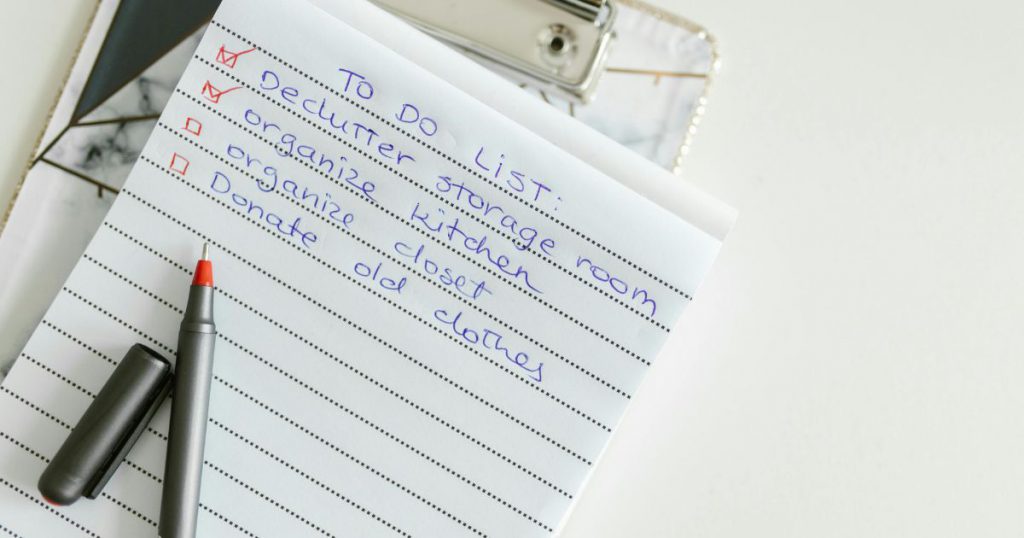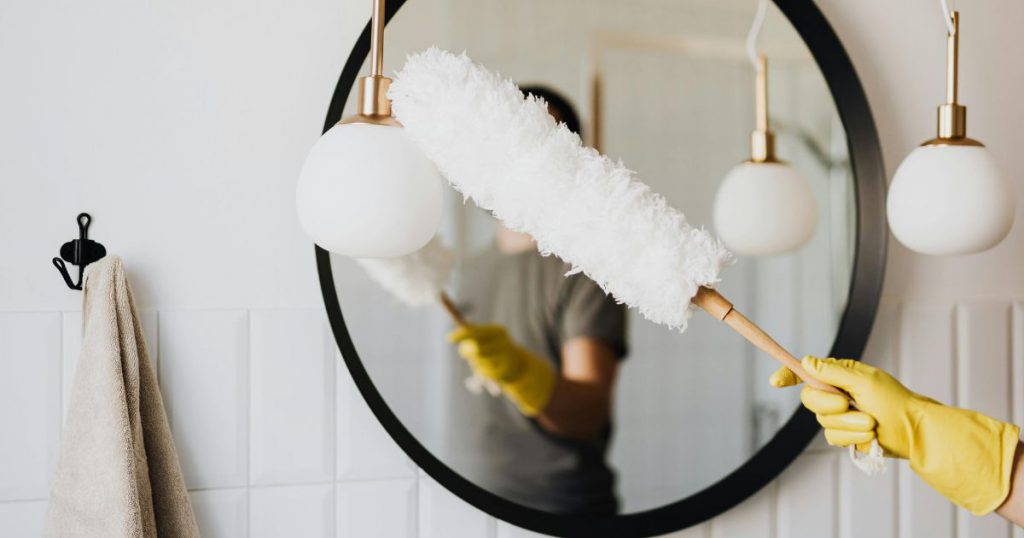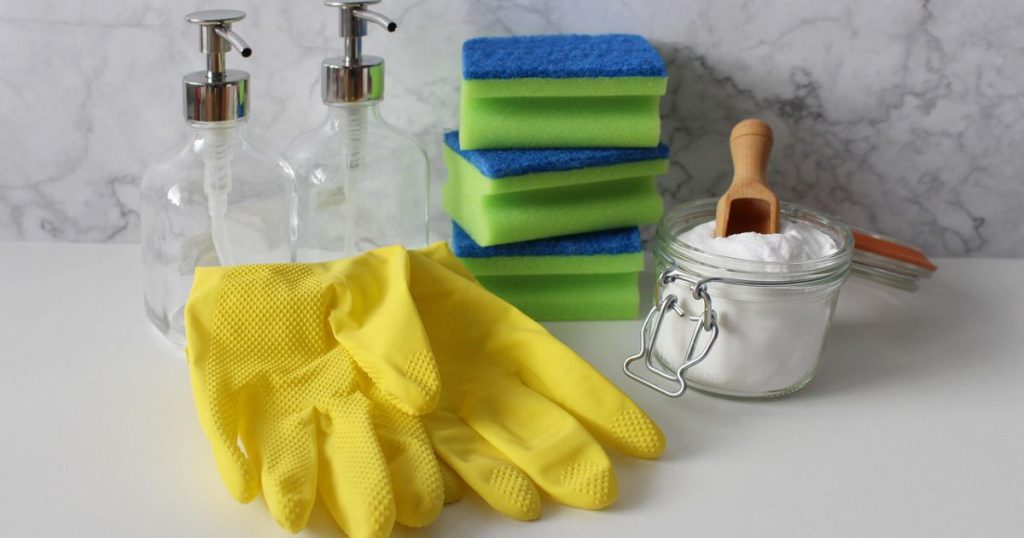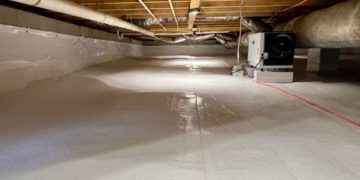
Some chores never really end. You clean one thing, and another needs to be wiped down. You fold one load of laundry: another’s already spinning. Sometimes, we’re on top of it: cleaning, drying, and folding it all in one day. But for the most part, those clean clothes spend at least a few business days in the dryer, waiting to be folded.
That’s just how life goes. So, how can you realistically stay on top of it all when your days are already maxed out? It starts with a home cleaning schedule that you can implement weekly and takes as little as 15 minutes daily.
How to Make a Weekly Cleaning Schedule

While we all love the idea of a spotless home with roommates, kids, and pets, it’s not always realistic. The real goal? Making your space easier to manage, one day at a time.
Daily Tasks: Keep Things Tidy Every Day
These quick daily habits keep things tidy, so you won’t have to declutter first when it’s time to clean.
- Make beds
- Declutter your space, especially high-traffic areas, such as the kitchen and living room
- Wipe down bathroom and kitchen counters
- Take out the trash, compost, and recycling
- Run or empty the dishwasher
Pro Tip: End your day with a 10-minute reset. Clear the counters, fold the blankets, and run the dishwasher. It’s probably the last thing you want to do before bed, but waking up to a tidy space makes it well worth the effort.
Weekly Deep-Cleaning Breakdown

Cramming all your cleaning into Sunday? That’s a fast track to burnout. Daily tasks seem like more work, but they actually make your house cleaning routine easier by preventing little tasks from snowballing into bigger ones.
Monday: Kitchen Reset
- Wipe down all your kitchen appliances, counters, and cupboard doors
- Scrub the sink and flush the drain with boiling water to keep things smelling fresh
- Clean and organized the fridge and pantry, tossing anything that has expired and making a note of what needs to be restocked
Tuesday: Floors and Restock
- Vacuum and mop floors, paying special attention to high-traffic areas like hallways, entryways, and the kitchen
- Spot-clean throw rugs if needed
- Restock household essentials (paper towels, cleaning supplies, and any other items you’re running low on)
Wednesday: Tidy Bedroom
- Change and launder sheets and pillowcases
- Dust furniture, décor, and light fixtures
- Vacuum floors and under beds
- Tidy up laundry piles or cluttered corners
Friday: Refresh Living Spaces
- Wipe down remotes, doorknobs, and other high-touch areas, such as light switches
- Clean handprints or pet smudges from glass doors and windows
Saturday: Laundry & Extras
- Tackle your laundry, including clothing, towels, and any bedding you didn’t do during the week
- Clean out pet areas or litter boxes
- Wipe down baseboards, ceiling fans, and bathroom vents
- Sort your mail, pay bills, shred junk, and file documents
- Dust surfaces and electronics
Sunday: Bathroom Deep Clean and Weekly Reset
- Scrub toilets, tubs, and sinks
- Clean mirrors and light fixtures
- Disinfect frequently touched surfaces
- Replace towels and restock toiletries
- Empty all household trash bins
- Water houseplants
- Do a quick overall tidy to prep your house for the week ahead
Tips for Staying Consistent in Your Home Cleaning Schedule
You won’t always feel like cleaning. Some days, the dust bunnies win, and that’s totally normal. Staying consistent in your weekly cleaning schedule isn’t about waking up inspired to scrub your baseboards. It’s about building micro-habits that make cleaning part of your routine. Here are a few strategies to help you stay on track.
Use a Printable or Digital Checklist
The best kind of to-do list is one that actually gets seen. Once you’ve nailed down your cleaning checklist, put it somewhere you’ll see daily. Stick it on the fridge, scribble it on your family whiteboard, or set it as your phone background—whatever works best for you.
Pro Tip: Setting digital reminders helps you stay on track when motivation wanes.
Involve the Whole Family
Cleaning shouldn’t fall on one person’s shoulders, so consider this your permission slip to stop doing it all yourself. Sharing the work gets it done faster and teaches kids (and, let’s be honest, occasionally partners) that mess doesn’t magically clean itself. Make cleaning a shared responsibility by assigning age-appropriate chores or creating a simple reward system. Even small tasks, such as your toddler picking up their toys, can help reduce the mental load.
Create a Cleaning Supplies Checklist

Nothing kills cleaning vibes faster than realizing you’re out of paper towels mid-scrub. Save yourself the drama with a cleaning supplies checklist. Keep it on your phone or taped inside a cupboard door and update it before you end up wiping down your baseboards with a sock.
Adjusting as You Go
Kids get sick, work piles up, and sometimes cleaning just isn’t the priority; that’s life. The goal isn’t to follow the house cleaning routine perfectly. It’s to have a rhythm you can return to when the dust settles—literally.
Flexibility for Busy Weeks
If you miss a task, move it to another day or let it go entirely. A skipped chore won’t undo your progress. Remember, the goal is consistency, not perfection.
Seasonal or Monthly Deep-Cleaning Additions
Not every task needs to happen weekly. Flipping mattresses, washing curtains, or tackling the garage fit better into a monthly or seasonal rotation. Pop them into your calendar in advance so they don’t sneak up on you; your future self will thank you.
A Home Cleaning Schedule That Feels Manageable
Your home should be a haven, not a source of stress. That’s why a weekly cleaning schedule matters. The goal isn’t perfection. It’s simply to make daily life feel lighter and leave your weekends open to relax, recharge, or do nothing at all.
If shuffling things from one spot to another is derailing your cleaning efforts, it might be time for a storage backup plan. With over 1,500 locations across the country, you can find a CubeSmart storage unit near you and clear the clutter, without letting go of what matters.







